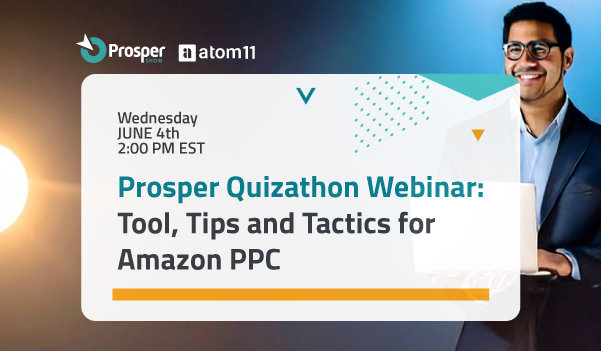Did you know that 82% of the ads served on Amazon are Sponsored Products ads (SPAs)? With so many sellers and brands using SPAs, the competition is fierce. You literally can’t afford to run flawed or unoptimized campaigns. Here are four common mistakes that sellers make using Sponsored Products ads as well as our suggestions for how you can avoid such pitfalls.
Mistake #1: Not Diving into the Data (or Diving in but Not Doing Anything with What You Discover)
Your Sponsored Products ad campaigns don’t just run silently in the background (or at least they shouldn’t). Think of it more as a conversation where you input variables and your campaigns report back to you with information that you can use to optimize them as well as your product listings.
Assuming that you can be totally hands-off with campaigns (even auto-target campaigns) is a costly mistake. Data speaks, and the more of it you have, the more it has to say and the louder it speaks. But for that to be of value, you have to learn to listen and to translate what you hear into action.
This means running campaigns and looking closely at them every few days so you can see what’s working and what’s not. But it’s not enough just to have this information in a report, you need to use this information to make adjustments such as:
-
- Lowering bids on poor performers or moving them to negative keywords
-
- Moving successful keywords to a more-specific match type (e.g., if a word is performing well as a broad match, try it in phrase match to see if you can get more bang for your buck)
-
- Increasing bids on stable performers to keep them winning rather than being overtaken by competitors willing to bid a penny higher
Do this sort of diving into reports and making adjustments on a keyword level, not across the board by just throwing more or less money at a campaign. The advantage you will have over the competition will be in maximizing narrow opportunities where your competitors either ignore the data or make broad-sweeping knee-jerk reactions to the whole rather than the pieces.
Mistake #2: Not Running Automatic Campaigns
It’s easy to fall into a trap where one thinks that auto-target campaigns are solely for PPC novices. But just because something is easier and requires less input and management doesn’t mean that it’s not without value. Even though we at Seller Labs make Ignite, a product that’s all about optimizing manual-target campaigns by getting deep down into the data, we still love auto-target campaigns for what they have to teach us.
For a relatively low spend, auto-target campaigns are great as a catch-all strategy for netting keyword wins you might have otherwise missed and for gathering search terms you would have not thought of yourself. The beauty of auto-target campaigns isn’t so much what they do but what they add, namely search terms and keywords that Amazon knows are associated with your ASIN but words and phrases that you couldn’t possibly have imagined would be connected. Basically, leaving a low-budget auto-target campaign running will still lead to impressions, clicks, and even conversions, and it will help you add valuable keywords from proven search terms.
One more benefit to running the auto-target net is that you’ll scoop up ASINs that are related to your product. ASINs in your report means that your product appeared on another product’s page and yours was clicked. This is the result of a user coming from Google or an external site. When the user clicks your product, Amazon associates the click with the ASIN rather than a keyword. Hence the ASIN in your report. This means that there is something in your listing and that other ASIN’s listing that Amazon has connected. When you see this, check the other ASIN to see what’s going on and to revise/optimize your listing so that you become the match rather than your competitor. Pick up on their Q&A and reviews and incorporate that type of information into your own listing. Turn a competitor’s negatives into your positives.
Mistake #3: Not Having Specific Goals for Your Campaigns
When we ask sellers what they want out of Sponsored Products ads, most respond with something vague such as “To knock my competition from the top placement and sell more. And to keep a low ACoS doing that.” Sure, we all want that. But what are you really trying to do within an individual campaign? What is the specific purpose of a campaign and what kind of performance would indicate its success?
5 Specific Purposes of Sponsored Products Ad Campaigns
There are five main purposes to Amazon SPA campaigns. Instead of just trying to sell a lot at your competitors’ expenses while keeping costs low, you should run campaigns with specific aims in mind and configured accordingly. Without these purposeful aims, the larger goal of driving sales from SPAs is merely a hope, which is not the same as a strategy. Each campaign should be driven with one of these purposes in mind:
-
- Awareness: This is the top of the funnel in terms of the buyer’s journey. The goal here is for a brand to use ads to make its products known to an audience that is likely to be interested in such products. As a seller going for awareness, you want people to know what you’re offering and to be interested enough to click on your ad rather than someone else’s.
-
- Branding: This ties into awareness. Branding is the process of developing a name and image for a company. Branding is achieved by using a consistent, distinctive style, voice, logo, etc. Branding takes time and patience and repetition. It’s a long game, but when it works, customers become fiercely loyal based on the perception of the brand’s unique value. As a seller going for branding via ads, you want to establish your brand as the go-to for a certain product or type of product.
-
- Consideration: This is the bottom of the funnel in terms of a shopper’s journey. The shopper has likely done research and comparison between similar products and he/she is closing in on making a purchase. Use this type of campaign when you want to have gone deep into the shopper’s selection process and, via your ad and listing details, turn the shopper into a customer.
-
- Playing Offense: This is taking an aggressive approach in terms of going after competitors’ keywords and being willing to outspend the competition. To do this requires investigative effort (using a reverse-ASIN tool like Scope to find keywords and optimize listings), time (reviewing data), and money (upping bids). This strategy is all about looking to go big and take calculated risks in terms of doing what it takes to grow by usurping competitors for top placement and capturing the resulting sales.
-
- Defensive Hold: This is about maintaining and protecting the placements you already have rather than spending more time and money taking risks in pursuit of growth. Here you’re trying to stave off competition by maintaining and monitoring your campaigns and making sure that you’re always the top bidder on your brand name.
Mistake #4: Not Understanding That a Campaign Is a Marathon—Instead of a Sprint—And That You Have to Spend Money to Make Money
No one wants to spend money on what doesn’t work, but the truth is that finding out what doesn’t work (so you don’t have to waste money on it) costs money. Treat your Sponsored Products ad campaigns as the investments that they are. Fund them, learn how to best manage them, keep contributing to them, take calculated risks, and get expert help managing them so that they can grow into profits. It doesn’t happen overnight and it doesn’t happen without strategy and a mindset of being in it to win it over the long term.
Clearly, creating PPC success with Sponsored Products ads is not for the impatient or the inflexible. Don’t be timid about your bids and your budgets. Come in with what you are willing to spend rather than starting off small and hoping to catch a deal (even if you do, sustaining the winning position takes nurturing). If you put a little more time and money into your campaigns upfront, you’ll quickly find out what works and what doesn’t and then you can stop spending on what doesn’t and start spending more on what does, which in turn will net you more. This is especially important during Q4 when your ads are amongst the 82% being served on Amazon and coming in bold can make all the difference when it matters most. See for yourself with a free 30-day trail of Seller Labs’ Ignite software for Amazon Sponsored Products ads management.
Seller Labs create innovative tools for Amazon Sellers. Our tools include: Feedback Genius for soliciting product and seller reviews, Scope for deep keyword and product research, Ignite for managing your Amazon Advertising Campaigns, and Quantify for providing deep insights into profitability.
This article authored by Lena Liberman, the senior copywriter at Seller Labs. She has nearly 20 years of editorial experience, heavily concentrated in the fields of technology, publishing, and education. When not gathering information and writing about it, Lena can be found restoring vintage furniture or hiking with her dogs.
* * * * * * * * * * * * * * * * * * * * * * * * * * * * * * * * * * * * * * * * * * * * * * * * * * * * * * * * * * * * * * * * * * * * * *
If you enjoyed this content, consider joining us at PROSPER Show, March 13-14, 2018 at the Las Vegas Convention Center.




Recent Comments